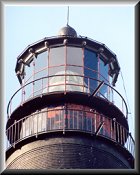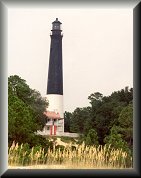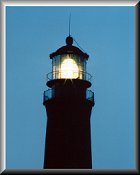|
|
|
Pensacola (Naval Air Station), Florida
All Photos © Tim N. Touchton
Each photograph
is available as an 8x10 for a cost of $ 12.00
plus $2.00 shipping. Check or money order only please.
%20Vert%20Button%20Web.jpg)
%20Horz%20Button%20Web.jpg)



%20Button%20Web.jpg)
I have taken many photographs of the Pensacola Lighthouse and these were
taken in late summer
of 1999 and 2000. I'm sorry I don't have the exact dates on these as I visit
this lighthouse often. My
all time favorite is the last photograph and it makes a BEAUTIFUL 8x10,
it is gorgeous. I took this
with a Canon EOS Elan II using a Canon 75-300 USM lens with a 6X star filter
shot with a 30 second
shutter setting. The big star only shows up about every couple of minutes
and lasts for about 20 seconds. At
first I hadn't noticed the big star because it came so rarely. I'm not sure
what is going on inside the Fresnel
lens that takes it so long between viewing. This 8x10 is beautiful and my
favorite photograph I've taken. I took
it from the beach at the mouth of the Pensacola pass at about 30 minutes past
sunset. One day I hope to get a
nice photograph of the lighthouse with Pensacola's own Blue Angels flying
in formation past it. Wow, what a
great photograph that would be. The lighthouse is located on the Pensacola
Naval Air Station and is easy to
find once you are on the Naval Base. Just ask at the guard station as you
enter the base.
I've gone fishing many a night in the Gulf off of Pensacola or in the Pensacola
pass itself and seen this great
light shining it's beacon for all to see. It's guided my dad in from many
fishing trips and is his friend. Something
to see that makes you feel at home, at peace and puts a smile on your face.
Home, I am home at last.....
Information about the present Pensacola Lighthouse:
Established: in 1858
Lit: on January 1, 1859
Materials: brick with concrete, granite foundation
Tower height: 150 feet
Tower height above sea level: 191 feet
Lens Optic: First-Order Fresnel
Light visible: 27 miles
Number of steps to lens: 177
Light pattern: white every 20 seconds
Lighthouse automated: in 1965
It is the fourth tallest lighthouse in the US
A brief history:
In September 1822 the Florida legislature sent a petition to James Monroe,
the President,
which included the establishment of a lighthouse at Pensacola Bay. The federal
government
was quick in transferring the lightship, Aurora Borealis from the mouth of
the Mississippi River
to Pensacola Bay and on June 22, 1823 the lightship was lit. The lightship
had a fifty-foot mast
with a set of lamps on top. However, this was at best a temporary fix, Pensacola
still needed a
lighthouse.
The site selected for a lighthouse was a bluff west of Fort Barrancas and
on December 20, 1824
the new lighthouse was lit for the first time. This Pensacola Lighthouse was
a short, round tower of
only 30 feet in height and 18 feet in diameter at the base. The short tower
was on a high bluff which
added to it's total focal height. The total height of the tower, on the bluff,
with the lantern on top put
it at 75 feet above sea level. The lantern consisted of 10 whale oil lamps
which flashed a beam of
light from 15 to 20 miles out.
In 1852 the Lighthouse Board recommended a "first class seacoast light"
for Pensacola. The existing
lighthouse was little better than the local lights that were along the coast.
They recommended the new
lighthouse have a First-Order Fresnel lens, be a height of at least 150 feet
and must be different from the
Mobile Point Lighthouse for ships at sea.
In 1856 a new site was selected for the second (and present) lighthouse in
Pensacola. The original site was
not a suitable place for the new tower and the new site was on the second
bluff west of Fort Barrancas, about
one half mile from the original lighthouse location. The new lighthouse was
first lit on January 1, 1859 and was
140 feet in height, 30 feet in diameter at it's base and 15 feet in diameter
at the top. The lantern at the top was
a First-Order Fresnel Lens, giving the total height of the lighthouse the
150 feet required. The total height of
the tower, the lens and the bluff it rested upon put the height 191 feet above
sea level.
On January 10, 1861 Florida succeeded from the Union. The Union troops stationed
at Fort Barrancas
left to stay at Fort Pickens across the bay, since they knew they were outnumbered
by state forces.
Florida and Alabama troops soon took control of all Federal property in Pensacola.
The troops used the
tower to spy on the Federal soldiers across the bay at Fort Pickens. On the
night of April 12 the Pensacola
Lighthouse was extinguished by the Confederates, due to Union reinforcements
landing across the bay at
Fort Pickens. On this same night the Confederate Army fired upon the Union
held Fort Sumter in Charleston,
South Carolina. The war had begun.
On November 22, 1861 Fort Pickens fired across the bay at Fort Barrancas
and the lighthouse. For 2 days
the firing didn't stop and the lighthouse was hit by Union artillery but caused
little damage. On December 20,
1862 the lighthouse was once again lit and in the hands of the Union troops.
The retreating Confederates destroyed
much of Pensacola in their retreat, but the lighthouse remained in good condition.
In 1875 the lighthouse suffered 2 lightning strikes and was hit by a tornado in 1877.
In 1938 the Pensacola Lighthouse entered the electrical age and with this
change the duties of a lighthouse keeper
became much easier.
Please visit the following links:
Pensacola
Lighthouse (by the Coast Guard Auxiliary)
Historic Lighthouse Publishers
(Pensacola Lighthouse)
![]()
COPYRIGHT INFORMATION - All
of the photographic images in this web
site as well as all of the written content in this web site are protected
by copyright and are not offered for commercial, public or personal use without
prior written consent. Please do not copy and/or distribute the images or
the written
content contained in this web site in print or digital form. Distributing
images
or the written content from this web site may put you or others at risk for
copyright violations.